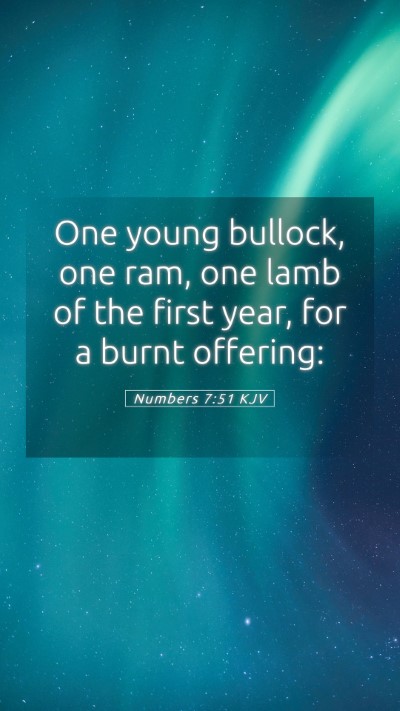Analysis of Numbers 7:51
Bible Verse: Numbers 7:51
Verse Text: "And the appointed portion of the peace offerings to the Lord shall be the breast that is waved and the thigh that is heaved."
Overview
Numbers 7:51 speaks to the specific offerings of peace that were to be presented to the Lord as part of the sacrificial system established for the people of Israel. This verse emphasizes the significance and the division of the offerings that were ordained by God, showcasing His instructions regarding holy worship.
Commentary Insights
-
Matthew Henry's Commentary
Henry highlights that this part of the peace offerings represents gratitude and acknowledgment of God's providence. The waving of the breast and the heaving of the thigh symbolizes God's acceptance of the offerings and the communion between God and man. The peace offerings serve a dual purpose: they are a form of thankfulness as well as a means of establishing fellowship with the divine.
-
Albert Barnes' Notes
Barnes notes that these specific actions related to the offerings act as a reminder of God's covenant with His people. The breast and thigh are chosen for their significance in the sacrificial process, indicating that certain parts of the offering were reserved for the priests and the worshipers. This practice reinforces the idea that worship involves a communal aspect where both God and His people partake in the offerings.
-
Adam Clarke's Commentary
Clarke elaborates on the ritual of the peace offerings, linking it to themes of joy and celebration. The wave offering denotes acceptance and inclusion, highlighting how the Israelite worship practices foster communal relationships. Clarke emphasizes how the specifics of the offerings reflect God's desire for order and reverence in worship.
Biblical Exegesis
This verse is part of a larger narrative concerning the consecration of the leaders and the establishment of offerings in the wilderness. Understanding this context is crucial for interpreting the significance of the peace offerings, as it denotes God's instructions on how worship is to happen among His people. Through this lens, we see a structured approach to worship that involves both specifics and general principles aimed at facilitating communion with God.
Key Themes and Applications
- Worship and Thanksgiving: The act of offering the peace offerings illustrates the importance of approaching God with a thankful heart.
- Community in Worship: Emphasizing that worship is not just an individual act but one that involves the community of believers.
- God’s Instructions: The precise directions from God regarding offerings highlight His desire for order and reverence in worship practices.
- Symbolism in Offerings: The parts of the animal designated for the offerings symbolize acceptance and the shared relationship between God and His people.
Cross References
- Leviticus 7:30-34: Discusses the wave offerings and the portions designated for priests.
- Exodus 29:27-28: Outlines the sanctification of offerings and their distribution.
- 1 Corinthians 10:21: Addresses the implications of participating in sacrifices in a New Testament context.
Conclusion
Understanding Numbers 7:51 offers valuable insights into the essence of sacrificial worship during the time of Moses. The rich symbolism within the act of offering and the communal aspects of worship emphasize the importance of thanksgiving and reverence toward God. Through verses like this, we glean significant principles applicable to our present-day worship practices, including the joy of offering our lives as a living sacrifice, as articulated in Romans 12:1.
Taking the time to study and understand the meaning of Bible verses like this allows individuals and Bible study groups to deepen their understanding of Scripture, fostering a more profound appreciation for the interconnectedness of biblical teachings.


